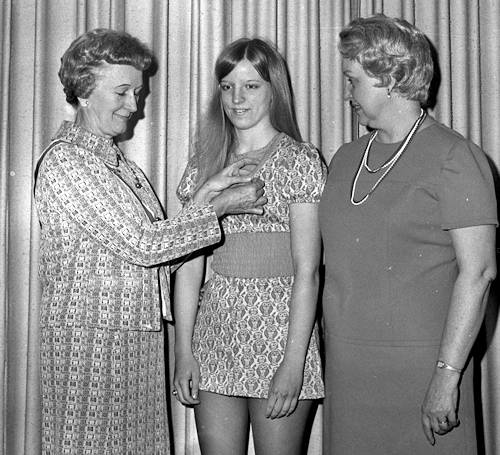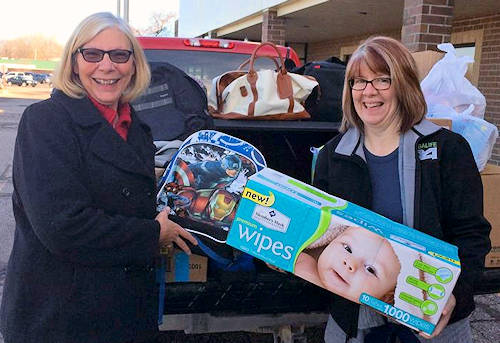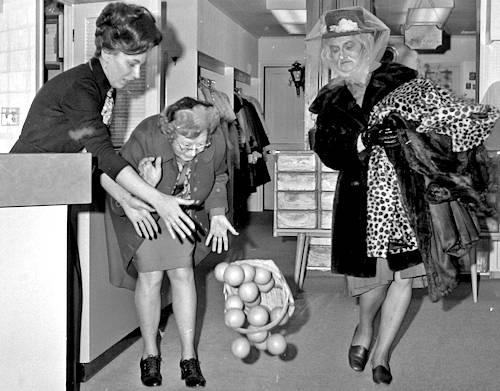Thankfulness and Gratitude
by Kelly L. Schafer, M.S., Executive Director, The Voice For Clinton County’s Children
The Voice for Clinton County’s Children is thankful and full of gratitude for what our agency experienced in 2017. Without you, our programs to serve children who have experienced abuse and neglect would not be possible.
Our Court Appointed Special Advocate (CASA) Program continues to provide a voice to Clinton County who are in foster care. CASA Volunteer Advocates give an average of 10 to 20 hours a month advocating on behalf of ‘their’ CASA kiddos ensuring no aspect of a child’s foster care experience is overlooked.
The last Saturday in April, we hosted our 4th Annual Superhero 5K Run, Walk, or Fly! a family-friendly (and fun!) event for all ages and abilities. We are thankful for our generous sponsors and all who ran and walked in support of our services. We are looking forward to April 28, 2018 to host our 5th Annual Superhero 5K Run, Walk, or Fly!-will your cape be ready?
Throughout the Spring and Summer, with an amazing team of volunteers, we made our new office a welcoming, child-friendly facility. Through generous donations from groups, families, and individuals, our office atmosphere includes brightly colored murals painted throughout our building.
In November we experienced the launch of our Child Advocacy Center (CAC). A CAC ensures abused children are not further victimized by the systems designed to protect them. Through CAC services, our wonderful professional team from throughout Clinton County, works together through the investigation, treatment, and potential prosecution of child abuse cases.

We invite individuals and groups to take a tour of our office. A Tour of Hope offers our community the opportunity to experience and learn about our programs which serve children who have been abused or neglected.
There are not enough words to express our thankfulness and gratitude to our community for the support which wraps its arms around the children we are entrusted to serve. We invite you to contact our office (989-640-5681) to schedule a Tour of Hope or for more information about our services to kids in our community, please visit VoiceForClintonCountyChildren.org.
A Look Back – DAR Event
by Barry Clark Bauer

Kathy Boettger, center, daughter of Robert and Marilyn Boettger, receives an award from the Daughters of the American Revolution in 1972.
The award is unknown as are the ladies making the presentation. It may be she just became a new member.
DAR was founded in 1890 and members serve to promote historic preservation, patriotism, and educational ideals in communities across this nation.
Benny and Jessie’s Pet Info – Christmas Wishes

On behalf of our furry friends, we wish our readers a Merry Christmas and Happy New Year from Maralyn and Jesie and the Pet Corner.
Letters – Parking permit confusion
Dear Law Enforcement Professionals:
Attached please find a copy of a notification I found on the windshield of my car parked in the St. John’s municipal lot just north of the police lot behind Heritage Place. I had a parking hang tag hanging from my rearview mirror, just 18 inches from the placement of this notice. Based on the information I received from Heritage Place, I thought this was a valid parking spot for my stay.
I appreciate the fact that I only got a warning rather than a real ticket. But I wish you and Heritage Place were on the same page about this parking.

I visit the St. John’s area frequently, and was pleased to see local lodging appear, as the Comfort Suites in Dewitt is noisy and I cannot get a good night’s sleep there. I like to support local businesses, especially new ones that seem to be serving a needed function in an area. But if I have to worry about getting a ticket due to poor communication between the businesses and the local law, I do not want to be the man in the middle.
I was sufficiently piqued that I decided to eat breakfast in Dewitt rather than St. Johns.
Before discovering the ticket, I joked to my wife that the accommodations were nice, and all St. John’s needed was a reason for people to want to visit. This experience encourages me to return to the Comfort Inn in Dewitt for my stays and meals while in the area.
And as more local businesses fail, and the tax base decreases, there will be less of a tax base to support local law enforcement jobs. I hope your small town starts working together for the benefit of all there. In the future, I will stop in Dewitt and bypass St. Johns on the Highway.
Sincerely,
Roger Fleming
******
Mr. Fleming,
Thank you for your email and for visiting St. Johns. The “notice” that was left on your vehicle was not a warning but rather a reminder that the city parking permits including those the hotel utilizes will be expiring at the end of December.
The purpose of the notices is to provide a reminder to those persons who utilize them to renew their permits in hopes that parking violations are not needed to be issued when the permits expire. All of the permits issued for the city lots including those for the hotel you referenced are identical. Due to that fact, the officers who are providing the “notices” as reminders would not be able to differentiate permits provided from the hotel for nightly guests from those issued to other permit holders in the city including residents and other business persons in the city.
I’m sorry you misinterpreted our “notice” as a warning. We enjoy a great working relationship with our downtown businesses and take extra steps to assure that information on upcoming renewals is provided in advance to reduce the need for violations being issued.
I hope this clarification on what was placed on your vehicle makes you feel less disappointed with your visit to our city. If there is any other clarification that I could provide that would assist you, please don’t hesitate to contact me.
Chief David Kirk
St. Johns Police Department
Maralyn’s Pet Corner – 5 Common Causes of Choking in Pets
When a dog or cat chokes, it can be a scary situation for any pet parent. Fortunately, if you know the most common choking hazards in pets, then you can get your pet the help she needs and, in some cases, prevent choking all together. Here are five common causes of choking in pets.
Foreign Objects
Curious dogs and cats explore their world by tasting and chewing, but sometimes they bite off more than they can chew. A dog can accidentally inhale whatever they are chewing on, and that can cause choking. Choking hazards include chew toys, balls, rawhides, bones, sticks, etc.—basically anything that is smaller than the windpipe or back of the throat can get stuck. It is a good idea to only let your dog chew on rawhides and toys under supervision, and take away the toy or rawhide when your dog chews it down small enough to swallow.
If your dog appears to be choking on a toy or rawhide, keep calm. A dog who is suffocating will panic and may accidentally bite. Avoid bite wounds and never put your hand in your dog’s mouth to retrieve the item. If your dog can still breathe, take your dog to your nearest veterinarian or veterinary emergency center immediately. If your dog can’t breathe, use the Heimlich maneuver to remove the item.
If your dog passes out, then and only then should you open the mouth and see if you can remove the item. Use both hands to open the mouth, and grasp the upper jaw while pressing the lips over the dog’s teeth so they are between the teeth and your fingers. Look inside your dog’s mouth and remove the obstruction if possible. If you can’t remove the object, try using a flat spoon to pry it out of the dog’s mouth.
Cats like to chew on and swallow string, which can cause choking if the string gets wrapped around their tongue. Veterinarians recommend storing all string and yarn out of reach of cats, and if you do play with your cat with feathered fishing poles or other string toys, store the toys out of reach when you are not actively playing with your cat.
Cats and dogs are also known to chew on electrical cords, and while electrocution doesn’t technically cause choking, it can cause pulmonary edema, which fills the lungs with fluid and restricts oxygen exchange. If you have a chewer, keep them safe by preventing any access to electrical cords.
Collapsing Trachea
Collapsing trachea is a common cause of choking in older small breed dogs. The trachea is the C-shaped cartilaginous windpipe that connects the nose and mouth with the lungs. In some small breeds, the windpipe becomes floppy, and the harder a dog sucks air in the trachea, the more collapsed it becomes, causing the dog to cough, sputter, and choke.
While there are some experimental procedures being tested at veterinary schools, at the time of writing, there is no cure for collapsing trachea. But if your dog has been diagnosed with a collapsing trachea, there are steps you can take to minimize the condition’s impact on quality of life. The most helpful recommendations are to keep a dog thin and cool, as excessive body weight and heat exacerbate the condition. If your dog is still struggling, talk with your veterinarian about getting cough medicine. If you are getting a puppy, talk with the breeder about the health of the mother and father, and ask if they have any problems. If the breeder doesn’t know, buy from a different breeder.
Infectious Disease
Kennel cough, also called infectious tracheobronchitis, is a highly contagious infectious respiratory disease in dogs that can mimic the signs of choking. Kennel cough is a catch-all term for several infectious organisms, and dogs catch it from other dogs or from sniffing up sputum coughed up by other dogs, much like you catch the common cold from somebody who sneezes on you. Kennel cough causes dogs to hack and cough like they have something caught in their throat. Sometimes affected dogs will spit up foam. Kennel cough is easily treated with antibiotics and cough medicine. You can prevent your dog from getting kennel cough by staying up-to-date on yearly bordetella vaccinations.
Another disease that can cause choking in dogs is puppy strangles. Puppy strangles is seen in young dogs, and the cause is unknown. Puppy strangles causes the swelling of the throat and lymph nodes, and flu-like symptoms.
Feline Asthma
Cats can develop hacking, coughing, labored breathing, and choking from asthma, which causes choking from constricted airways. Feline asthma is an allergic disease, caused by reactions to environmental allergens, such as dust mites or pollen. Feline asthma is a chronic inflammatory condition and there is no cure, however, symptoms can be managed with medications and allergen avoidance.
Constricting Collars
An often overlooked cause of choking in dogs and cats is a collar that is too tight, or a collar that becomes tight when a dog pulls on the leash. Collars can quickly become too tight in fast-growing puppies and kittens, so make sure to check the collar often on puppies and kittens, and keep it loosened enough to slip two fingers under the collar. If your dog pulls excessively on the leash and then chokes and coughs, then she could benefit from being trained to stop pulling through the use of a head halter or harness that is specially designed to reduce pulling.




























 On October 25, 1917, Louis Frederick (Fred) Mayers was born in DeWitt, Michigan to Louis and Ethyl Mayers. The family moved to St. Johns and resided in Clinton County from then on.
On October 25, 1917, Louis Frederick (Fred) Mayers was born in DeWitt, Michigan to Louis and Ethyl Mayers. The family moved to St. Johns and resided in Clinton County from then on.